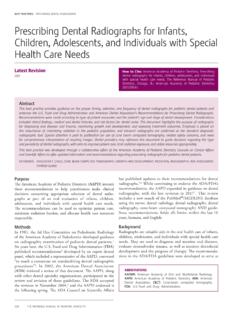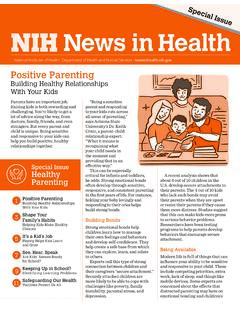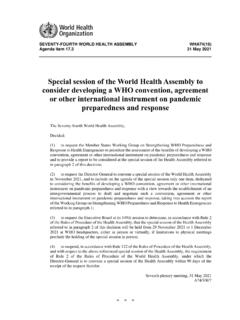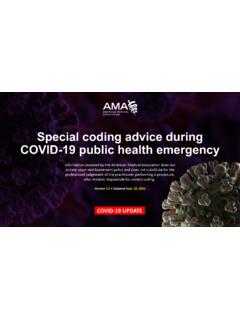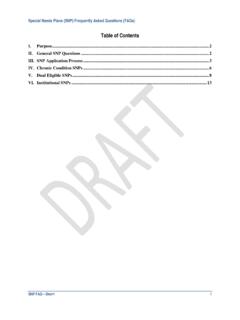Transcription of ARMY HEALTH SYSTEM SUPPORT TO ARMY SPECIAL …
1 *ATP ARMY HEALTH SYSTEM SUPPORT TO. ARMY SPECIAL OPERATIONS FORCES. December 2015. DISTRIBUTION RESTRICTION: Approved for public release; distribution is unlimited. *This publication supersedes FM , Force HEALTH Protection SUPPORT for Army SPECIAL Operations Forces, dated 27 November 2006. Headquarters, Department of the Army This publication is available at Army Knowledge Online ( ). To receive publishing updates, please subscribe at *ATP Army Techniques Publication (ATP) Headquarters No. Department of the Army Washington, , 17 December 2015. Army HEALTH SYSTEM SUPPORT to Army SPECIAL Operations Forces Contents Page iv INTRODUCTION .. v Chapter 1 OVERVIEW OF ARMY HEALTH SYSTEM SUPPORT .. 1-1. Purpose .. 1-1. Roles of Medical Care .. 1-1. Principles of the Army HEALTH SYSTEM .. 1-2. Army HEALTH SYSTEM Medical Functions .. 1-3. Chapter 2 SPECIAL OPERATIONS FORCES MISSIONS AND 2-1. Core Activities of Army SPECIAL Operations Forces .. 2-1. SPECIAL Operations Core Activities .. 2-1.
2 Mission Tasking 2-2. Army SPECIAL Operations Force Organizations .. 2-2. Medical Capabilities of Army SPECIAL Operations Forces .. 2-3. Medical Personnel in Army SPECIAL Operations Forces .. 2-4. Chapter 3 ARMY HEALTH SYSTEM AND ARMY MEDICAL DEPARTMENT. FUNCTIONS IN SUPPORT OF ARMY SPECIAL OPERATIONS FORCES .. 3-1. Medical Evacuation .. 3-1. Medical Treatment (Organic and Area SUPPORT ) .. 3-2. Hospitalization .. 3-3. Medical Logistics .. 3-3. Preventive Medicine Services .. 3-3. Veterinary Services .. 3-3. Dental Services .. 3-3. Combat and Operational Stress Control .. 3-4. Medical Laboratory Services .. 3-4. Distribution Restriction: Approved for public release; distribution is unlimited. *This publication supersedes FM , Force HEALTH Protection SUPPORT for Army SPECIAL Operations Forces, dated 27 November 2006. i Contents Medical Mission Command .. 3-4. Conventional Versus SPECIAL Operations Forces Army HEALTH SYSTEM SUPPORT .. 3-4. Chapter 4 PLANNING ARMY HEALTH SYSTEM SUPPORT TO ARMY SPECIAL .
3 OPERATIONS FORCES .. 4-1. HEALTH Threat .. 4-1. Army SPECIAL Operations Forces Planning for Army HEALTH SYSTEM SUPPORT .. 4-1. Chapter 5 ARMY SPECIAL OPERATIONS FORCES IN A JOINT OPERATIONS. AREA .. 5-1. The Joint Task Force .. 5-1. SPECIAL Operations Forces in Joint Operations .. 5-1. Army HEALTH SYSTEM Considerations in Joint Task Force Planning .. 5-1. Chapter 6 MEDICAL LOGISTICS SUPPORT TO ARMY SPECIAL OPERATIONS. FORCES .. 6-1. The Army SPECIAL Operations Forces Medical Logistics Requirements .. 6-1. Duties and Responsibilities for the Management of Medical Logistics .. 6-3. Appendix A ARMY SPECIAL OPERATIONS FORCES AND MEDICAL CONSIDERATIONS. IN THE LAW OF A-1. Appendix B PLANNING MEDICAL EVACUATION FOR ARMY SPECIAL OPERATIONS. FORCES .. B-1. Appendix C MISSION COMMAND STRUCTURES AND INTEGRATING ELEMENTS OF. SPECIAL OPERATIONS FORCES IN THE JOINT CAMPAIGN .. C-1. GLOSSARY .. Glossary-1. References-1. INDEX .. Index-1. ii ATP 17 December 2015. Contents Tables Table 4-1. Army HEALTH SYSTEM requirements for direct action activities.
4 4-3. Table 4-2. Army HEALTH SYSTEM requirements for SPECIAL reconnaissance 4-4. Table 4-3. Army HEALTH SYSTEM requirements for foreign internal defense activities .. 4-6. Table 4-4. Army HEALTH SYSTEM requirements for unconventional warfare activities .. 4-8. Table 4-5. Army HEALTH SYSTEM requirements for counterterrorism activities .. 4-10. Table 4-6. Army HEALTH SYSTEM requirements for countering weapons of mass 4-12. Table 4-7. Army HEALTH SYSTEM requirements for civil affairs operations .. 4-13. Table 4-8. Army HEALTH SYSTEM requirements for military information SUPPORT operations .. 4-15. 17 December 2015 ATP iii Preface The purpose of Army Techniques Publication (ATP) is to provide the authoritative doctrine for the Army Medical Department's (AMEDD's) Army HEALTH SYSTEM (AHS) SUPPORT of Army SPECIAL operations forces (ARSOF) as part of the protection and sustainment warfighting functions SUPPORT to unified land operations. Army SPECIAL operations forces are those Active Army and Reserve Component forces designated by the Secretary of Defense that are specifically organized, trained, and equipped to conduct and SUPPORT SPECIAL operations.
5 The acronym ARSOF represents SPECIAL forces (SF), SPECIAL mission units, Rangers, civil affairs (CA), military information SUPPORT operations (MISO), and Army SPECIAL operations aviation forces assigned to the United States Army SPECIAL Operations Command (USASOC), which are all supported by the sustainment brigade ( SPECIAL operations) (airborne) (SB[SO][A]). This publication also discusses joint SPECIAL operations and provides a limited discussion of other Services capabilities. The principal audience for this publication includes commanders at all levels to provide a universal understanding of how AHS must function to SUPPORT ARSOF; ARSOF and medical unit commanders and their staffs; doctrinal proponents to institutionalize the integration of AHS SUPPORT into all Active Army, joint force, and multinational missions that contain ARSOF. Commanders, staffs, and subordinates ensure their decisions and actions comply with the applicable United States ( ), international, and, in some cases, host-nation laws and regulations.
6 Commanders at all levels ensure their Soldiers operate in accordance with the law of war and the rules of engagement. Refer to Field Manual (FM) 27-10. Army Techniques Publication implements or is in consonance with the following North Atlantic Treaty Organization (NATO) Standardization Agreements (STANAGs) and American, British, Canadian, Australian, and New Zealand (Armies) (ABCA) Publication: Title NATO STANAGs ABCA Publication Information Relative to Medical Evacuation, Treatment and Cause of Death of ABCA Casualties 363. Medical Employment of Air Transport in the Forward Area 2087. Documentation Relative to Initial Medical Treatment and Evacuation (Allied Medical 2132. Army Techniques Publication uses joint terms where applicable. Selected joint and Army terms and definitions appear in both the glossary and the text. For definitions shown in the text, the term is italicized and the number of the proponent publication follows the definition. This publication is not the proponent for any Army terms.)
7 This publication applies to the Active Army, Army National Guard/Army National Guard of the United States, and the United States Army Reserve, unless otherwise stated. The proponent and preparing agency of ATP is the Commander, United States Army Medical Department Center and School, United States Army HEALTH Readiness Center of Excellence. Send comments and recommendations on a DA Form 2028 (Recommended Changes to Publications and Blank Forms) to Commander, United States Army Medical Department Center and School, United States Army HEALTH Readiness Center of Excellence, ATTN: MCCS-FDL (ATP ), 2377 Greeley Road, Building 4011, Suite D, JBSA Fort Sam Houston, Texas 78234-7731; by e-mail to or submit an electronic DA Form 2028. All recommended changes should be keyed to the specific page, paragraph, and line number. A rationale for each proposed change is required to aid in the evaluation and adjudication of each comment. iv ATP 17 December 2015. Introduction Army Techniques Publication remains generally consistent with FM on key topics while adopting updated terminology and concepts, as necessary.
8 Army HEALTH SYSTEM SUPPORT to ARSOF is challenging in that ARSOF are lightly equipped with limited organic SUPPORT assets. Therefore, they must be self-sustaining in all areas of medical care throughout the range of military operations. Since they routinely operate in undeveloped joint operational areas without established SUPPORT systems, ARSOF. medical personnel must assume both AHS missions of HEALTH service SUPPORT (HSS) and force HEALTH protection (FHP) responsibilities. Army Techniques Publication contains the following six chapters and three appendixes: Chapter 1 provides an overview of AHS SUPPORT and its mission to provide HEALTH care to Soldiers across the range of military operations. It identifies and discusses the purpose of the AHS, reviews the roles of medical care and the AHS principles. Chapter 2 discusses the missions and activities of ARSOF. It also examines ARSOF medical capabilities and the range of medical personnel and their responsibilities serving in ARSOF.
9 Chapter 3 lists the AMEDD medical functions and their relationship to ARSOF. In addition, there is a comparison of AHS SUPPORT between conventional forces and ARSOF. Chapter 4 discusses planning for AHS SUPPORT to ARSOF. It focuses upon planning requirements for a number of core activities. Chapter 5 focuses upon AHS SUPPORT to ARSOF in joint operations and the various considerations involved in joint task force (JTF) planning. Chapter 6 examines medical logistics (MEDLOG) SUPPORT to ARSOF and its unique requirements. Appendix A provides an explanation of the law of war, which includes the Geneva Conventions, and the protections afforded to conventional medical personnel, medical aircraft, and medical materiel. Appendix B discusses medical evacuation planning in the SUPPORT of ARSOF missions and units. Appendix C discusses the relationship between SPECIAL operations (SO) mission command in the joint environment. 17 December 2015 ATP v This page intentionally left blank. Chapter 1.
10 Overview of Army HEALTH SYSTEM SUPPORT The AHS is designed to provide HEALTH care to our Soldiers across the entire range of military operations from austere environments to well-staffed and -equipped medical treatment facilities (MTFs). It is responsible for the operational management of the HSS and FHP missions for training, predeployment, deployment, and postdeployment operations. Although many features of ARSOF are common to conventional forces, some unique differences in tactical employment are necessary for ARSOF. The differences arise primarily in how medical assets are employed and the operational, tactical, and geographical constraints that routinely confront ARSOF. medical capabilities. Medical planners should review recent lessons learned from operations such as Operation Iraqi Freedom, Operation New Dawn, and Operation Enduring Freedom, and be prepared to integrate ARSOF SUPPORT operations into their planning process. For a more detailed overview of the AHS, refer to FM 4-02.










